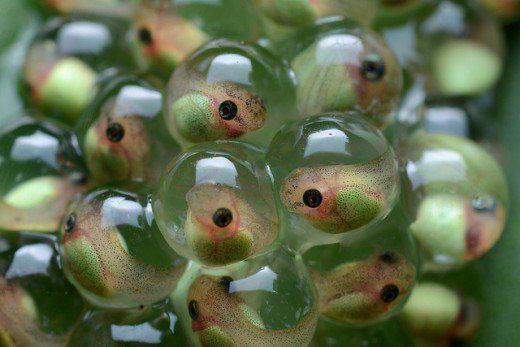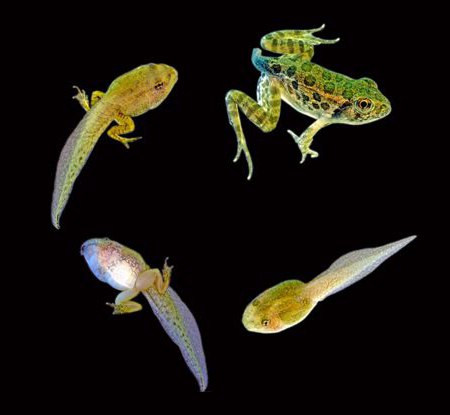The frog's life cycle , gametogenesis, fertilization and other seasonal events depend on numerous external factors. The life of almost all amphibians depends on the number of plants and insects in the pond, as well as the temperature of the air and water. There are various stages of development of frogs, including larval (egg - embryo - tadpole - frog). The metamorphosis of the tadpole into an adult is one of the most striking transformations in biology, since these changes prepare the aquatic organism for a terrestrial existence.
The development of frogs: photo
In tailless amphibians, such as frogs and toads, metamorphic changes are most pronounced, almost every organ undergoes modification. The shape of the body changes beyond recognition. After the appearance of the hind and forelimbs, the tail gradually disappears. The cartilaginous skull of the tadpole is replaced by the facial skull of a young frog. The horny teeth that the tadpole used to eat pond plants disappear, the mouth and jaws take on a new shape, the muscles of the tongue develop more strongly to make it easier to catch flies and other insects. The elongated colon, characteristic of herbivores, is shortened to adapt to the carnivorous diet of an adult. At a certain stage in the development of frogs, the gills disappear, and the lungs increase.
What happens immediately after fertilization?
Shortly after fertilization, the egg begins to pass from one cell stage to another in the process of division. The first cleavage starts from the animal pole and extends vertically down to the vegetative pole, dividing the egg into two blastomeres. The second cleavage occurs at right angles to the first, dividing the egg into 4 blastomeres. The third furrow is located at right angles to the first two, being closer to the animal than to the vegetative pole. It separates the four upper small pigmented areas from the four lower ones. At this stage, the embryo already has 8 blastomeres.

Further splits become less regular. As a result, a unicellular egg gradually turns into a unicellular embryo, which at this stage is called a blastula, which even at the stage of 8-16 cells begins to acquire spatial cavities filled with liquid. After a series of changes, a single-layer blastula turns into a two-layer embryo (gastrula). This complex process is called gastrulation. The intermediate stages of frog development at this stage imply the formation of three protective layers: ectoderm, mesoderm, and endoderm, which are also known as primary
germ layers
. Later, larvae hatch from these three layers.
Tadpoles (larval stage)
The next stage of development of the frog after the embryo is the larva, which leaves the protective shell 2 weeks after fertilization. After the so-called release, the frog larvae are called tadpoles, which are more like small fish about 5-7 mm long. The body of the larva includes a distinct head, trunk and tail. The role of the respiratory organs is played by two pairs of small external gills. A fully formed tadpole has organs adapted for swimming and breathing; the lungs of a future frog develop from the pharynx.
Unique metamorphoses
The water tadpole undergoes a series of changes, which eventually transform it into a frog. During metamorphosis, some larval structures are reduced, and some change. Metamorphoses initiated by thyroid function can be divided into three categories.
1. Changes in appearance. Hind limbs grow, joints develop, fingers appear. The forelimbs, still hidden by special protective folds, go outside. The tail is reduced, its structures break and gradually nothing remains in its place. Eyes from the sides go to the upper part of the head and become bulging, the system of the lateral line of organs disappears, the old skin is discarded, and new, with a large number of skin glands, develops. Horny jaws fall away with larval skin, they are replaced by true jaws, first cartilaginous, and then bone. Rupture of the mouth is greatly increased, allowing the frog to eat large insects.
2. Changes in internal anatomy. The gills begin to lose their meaning and disappear, the lungs become more and more functional. Corresponding changes occur in the vascular system. Now the gills gradually cease to play a role in the blood circulation, more blood begins to flow into the lungs. The heart becomes three-chambered. The transition from predominantly plant foods to a purely carnivorous diet affects the length of the digestive canal. It shrinks and twists. The mouth becomes wider, the jaw develops, the tongue enlarges, the stomach and liver also become larger. Pronephros is replaced by mesospheric kidneys.
3. Changes in lifestyle. During the transition from the larva to the adult stage of development of frogs, the amphibian lifestyle changes with the onset of metamorphosis. It often rises to the surface to swallow air and inflate the lungs.

Little Frog - A miniature version of an adult frog
At the age of 12 weeks, the tadpole has only a small tail residue and in appearance resembles a reduced version of an adult individual, which, by the 16th week, as a rule, completes the full growth cycle. The development and species of frogs are interconnected, some frogs that live at high altitudes or in cold places can live in the tadpole stage all winter. Certain species may have their own unique stages of development, which differ from traditional ones.
Frog life cycle
Most frogs breed in the rainy season when ponds are flooded with water. Tadpoles, whose nutrition is different from that of adults, can take advantage of the abundance of algae and vegetation in the water. The female lays eggs in a special protective jelly under water or on plants located nearby, and sometimes does not even care about offspring. Initially, embryos absorb their yolk reserves. As soon as the embryo has turned into a tadpole, the jelly dissolves and the tadpole leaves its protective shell. The development of frogs from eggs into an adult is accompanied by a number of complex changes (appearance of limbs, tail reduction, internal organ remodeling, and so on). As a result, an adult animal in its structure, lifestyle and habitat is significantly different from previous stages of development.